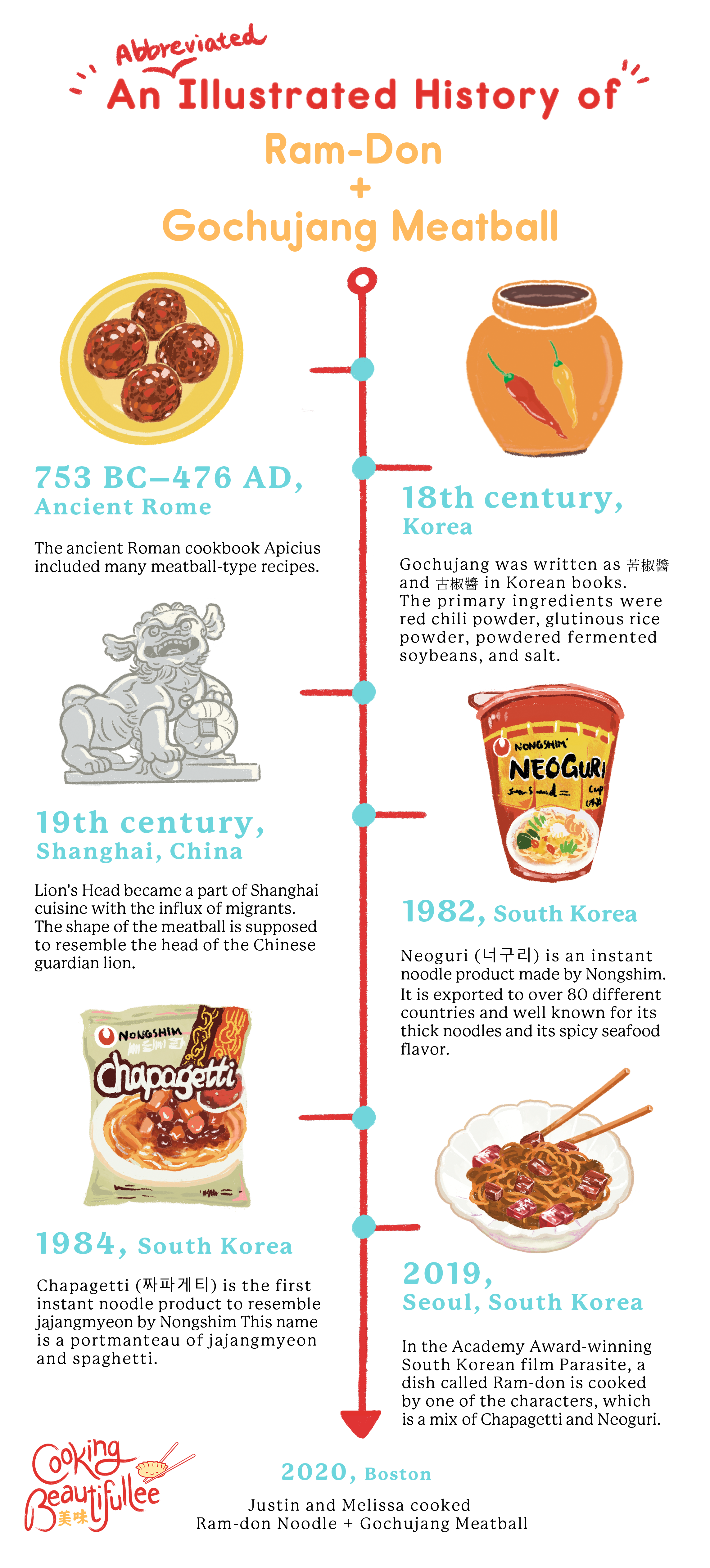Ram-Don Noodles
By Melissa Lee
“You are what you eat” means the food you choose to consume daily is part of your identity. If you think food is merely fuel, think again. Food can tell you so much about a person: their ethnic background, family background, financial
situation, and health condition. Parasite, the Korean Oscar-winning film directed by Bong Joon-Ho, portrayed the class disparities through aesthetics, architecture, body odors, and food. One dish that I saw in this movie and can never forget was the ram-don noodle.
This movie is about the Kims, a low-income family who tricked their way into working for the wealthy Park family. The Parks left the house for a camping trip and decided to drive back home because it was raining. On their way back, Mrs. Park calls her housekeeper, Mrs. Kim, to request that she prepare a bowl of ram-don noodles for her young son and have it be ready by the time they arrive home. Mrs. Kim hung up, confused. She didn’t know what ram-don noodles were. So, she threw together two types of instant noodles and some hanu steak cubes. Mrs. Park was pleased and ate the entire bowl.
You might be wondering what ram-don noodles are just like Mrs. Kim. One day, I was listening to a podcast interview with Mangchi, the Korean YouTube star, and even she was baffled by this word since she has never heard of it. After watching the movie, she said ram-don is basically jjapaguri—a combination of two types of instant noodles. The term “ram-don” was invented for the film by subtitle translator, Darcy Paquet, as the actual Korean name for the dish, jjapaguri, which was too difficult to translate for an English-speaking audience. Paquet figured audience members would be familiar with “ramen” and “udon,” and so he mashed up the two.
What made the ram-don noodles cooked for the Park family special was the hanu steaks—a premium Korean beef, similar to Japanese wagyu. Hanu steak can be twice the cost of beef imported from Australia or the U.S., and the Park family can casually request a good amount of this beef at any occasion, even to add to the humble instant noodles. Because of the high-quality steak, this ram-don noodle is not your average midnight snack.
I was intrigued by this dish, but I don’t want to break our bank to replicate it. I also want to make it healthier, so I decided to add vegetables to brighten the dish and serve it with gochujang meatballs. Ground meat and gochujang glaze are more affordable than hanu or wagyu steak. The price is less than half, but the deliciousness is doubled, especially when you cook this dish with love!

Ram-Don Noodle
Equipment
- Cutting board
- Chef’s knife
- Measuring cups and spoons
- Heavy bottom large sauté pan
- Paper towels
- Plate
- Metal spatula
- Rubber spatula
- Medium-large pot to cook noodles
- Colander
- Tongs
Ingredients
- 2 packages Chapagetti noodles
- 2 packages Neoguri noodles
- 1 ½ cups Beef broth unsalted (homemade is best but store-bought will work)
- 1 ea. English cucumber
- 1 ea. Red bell pepper
- 2 Tbsp. + 1 tsp. Canola oil
- 1 bunch Scallions sliced thin
- 1 ea. Lime cut into 4 wedges
- 1 Recipe of our Gochujang meatballs
Instructions
- Split the cucumber in half with a knife. Heat a heavy bottom sauté pan on high heat. Put in 1 tsp. of the canola oil, and using a paper towel, wipe the oil leaving just a thin layer. The pan should be smoking hot. Place the cucumber flat side down and press down with a metal spatula leaving the pan on high heat. Once the cucumber has a good char on the flat side, remove it from the pan and place on the cutting board to cool. Clean the sauté pan to cook the peppers.
- Cut the red bell pepper in half, remove the stem, seeds, and ribs. Cut the bell pepper into ½” strips. In the large sauté pan on high heat, add in 2 tbsp. of canola oil and let the oil heat to smoking. Carefully add in the peppers and leave on high heat. Continue to cook until the peppers are soft and have a good char but not completely burnt. Moderate the pan heat as needed. Line a plate with a paper towel and lay out the peppers on the plate to cool.
- Once the cucumber is cooled, cut it into half-moon shapes about ½” thick. Add to the peppers and keep aside.
- In a medium-large saucepot, bring 2 quarts of water to a rolling boil. Add the instant noodles and stir to make sure they cook evenly. Cook the noodles for about 2-3 minutes. Test a noodle to make sure it is al dente. Drain the cooked noodles into a colander.
- In the same pot add in the 1 ½ cups of unsalted beef broth. Turn on medium heat. Add in the black bean-seasoning packet from the Chapagetti and only half of the seasoning powder from the neoguri package. If you like it spicy, add the whole pack from the Neoguri package. Bring the sauce to a boil.
- Add in the meatballs and cook for 2 minutes to warm them through.
- Add in the cooked noodles to the pot of meatballs and sauce. Continue to simmer to reduce the sauce and coat the noodles and meatballs, stirring often with a rubber spatula.
- Add in the cut charred cucumber and peppers and fold in the noodles with a rubber spatula. Add in the oil pack from the Chapagetti at the end and fold together. Finish by folding in the thinly sliced scallions, reserving some to place on top.
- Place the noodles into four bowls with the meatballs. Put some of the sliced scallions on top. Serve with the lime wedge on the side and kkakdugi radish banchan. Serve immediately
Notes
Storage Tips
This dish is best served fresh but could be cooled, stored in the refrigerator, and reheated with a little bit more beef broth or a touch of water in a pan over medium-low heat until hot. A microwave to reheat would work as well.Chef’s Tips
Cooking noodles should be done in plenty of boiling water and stirred often to promote even cooking. We do not season the water to cook the noodles because the sauce has so much salt and flavor. Other seasonal vegetables can be added to the dish as well. Carrots, squash, cauliflower, or whatever is fresh and best looking at your local store would work. We add some char to the vegetables to add a dimension of flavor. We suggest you use whatever vegetable you prefer. This dish is traditionally done with a seasoned and high-quality cut of cooked steak. We are just putting our twist on the recipe with the spicy gochujang meatballs.Join Our Community at Patreon
Perks for Friends of Food Patrons only:
Friends of Food is a digital members-only community designed to empower and connect food folks alike.
- Invitation to private community & food folk directory
- Access to a highly vetted network of Chefs
- One hour Zoom cooking lesson once a month
- Cookbook club + happy hour once a month
- 30 mins cooking consultation
- E-mail us your cooking questions and we will get back to you with our best answer within a week.
- Shoutout
- Polls (Help us choose a topic for an upcoming video + more!)
- Behind-the-scenes / Bloopers
- Exclusive perks from brand partners
Here are the Amazon affiliate links for you to order the ingredients and tools to create this delicious dish.
Epicurean Gourmet Series Cutting Board, 17.5-Inch by 13-Inch, Natural/Slate
Miyabi 34313-213 Fusion Morimoto Edition Chef's Knife, 8-inch, Black w/Red Accent/Stainless Steel
Le Creuset Signature Cast Iron Round Skillet Grill, 10-1/4-Inch, Cherry
OXO 1134700 Good Grips 5-Quart Stainless-Steel Colander, Silver
OXO Good Grips 16" Tongs Stainless Kitchen Tool
Le Creuset N5100-2017 Stockpot, 6-Quart, Caribbean
Le Creuset JS410-17 Craft Series Medium Spatula, 11 1/8" x 2 1/4", Caribbean

Melissa Lee
Chief Entertainment Officer
Melissa is 100% MIT (Made in Taiwan), where she worked as a food writer. She’s also worked alongside renowned chefs like Ming Tsai and Joanne Chang, honing her craft and gathering stories along the way. Part story-teller, part educator, and part food lover, Melissa brings a special blend of experience, skill, and enthusiasm to her work. She blends her Asian background, her new home of New England, and love of food and culture to bring joy, optimism, and inspiration to food lovers and fun-seekers everywhere.
What sparked your passion for the industry?
The desire to make things by hand. The joy of sharing delicious, hearty food with students. The opportunity for people to get connected via cooking and baking. When a child smiled broadly and told me it’s the best scone he has ever made and eaten, it really made my day!
In your opinion, what’s the most important course?
Well, I usually take a peek at the wine list first. I like tapas style, so the course doesn’t really matter. Cheese and charcuterie are always a good place to start. And since I’m a pastry chef, there is always room for dessert!
Bill Gates is picking up your tab, where would you go?
Noma, Copenhagen.


Thank you for teaching us the rules of making ramen. I did not ask the question does the broth give the noodles the flavor or are the noodles flavored already?
The broth gives the noodle flavors. 🙂